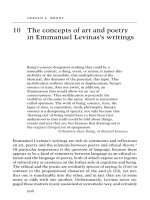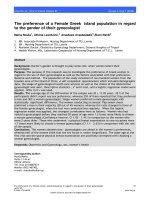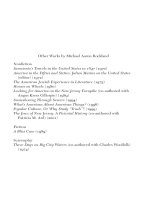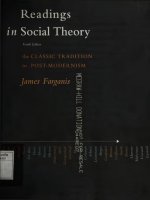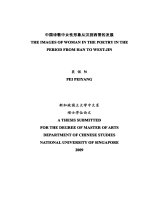Greek christian poetry in classical forms the codex of visions from the bodmer papyrus and the melding of literary traditions
Bạn đang xem bản rút gọn của tài liệu. Xem và tải ngay bản đầy đủ của tài liệu tại đây (727.89 KB, 190 trang )
GREEK CHRISTIAN POETRY IN CLASSICAL FORMS: THE CODEX OF
VISIONS FROM THE BODMER PAPYRI AND THE MELDING OF
LITERARY TRADITIONS
Kevin James Kalish
A DISSERTATION
PRESENTED TO THE FACULTY
OF PRINCETON UNIVERSITY
IN CANDIDACY FOR THE DEGREE
OF DOCTOR OF PHILOSOPHY
RECOMMENDED FOR ACCEPTANCE
BY THE DEPARTMENT OF
COMPARATIVE LITERATURE
Adviser: Daniel Heller-Roazen
June 2009
UMI Number: 3356722
Copyright 2009 by
Kalish, Kevin James
All rights reserved
INFORMATION TO USERS
The quality of this reproduction is dependent upon the quality of the copy
submitted. Broken or indistinct print, colored or poor quality illustrations and
photographs, print bleed-through, substandard margins, and improper
alignment can adversely affect reproduction.
In the unlikely event that the author did not send a complete manuscript
and there are missing pages, these will be noted. Also, if unauthorized
copyright material had to be removed, a note will indicate the deletion.
______________________________________________________________
UMI Microform 3356722
Copyright 2009 by ProQuest LLC
All rights reserved. This microform edition is protected against
unauthorized copying under Title 17, United States Code.
_______________________________________________________________
ProQuest LLC
789 East Eisenhower Parkway
P.O. Box 1346
Ann Arbor, MI 48106-1346
© Copyright by Kevin James Kalish, 2009. All rights reserved.
ABSTRACT
This dissertation presents a new chapter in the story of Christian culture’s
engagement with classical literary culture. The Codex of Visions, part of the Bodmer
Papyri discovered in upper Egypt in 1952, provides the material for my study. This
codex contains previously unknown and anonymous Greek Christian poems dating
from the mid-fourth to the mid-fifth century. The nature of the codex is eclectic, and I
base my analysis on four narrative poems from the codex. These poems, though
composed according to classical prosody and employing archaic diction, nonetheless
deal with Christian themes, from visions of heaven to retellings of Bible episodes. I
argue that these poems show how Christian poets in Late Antiquity melded Christian
and classical traditions to form a new type of poetry.
Chapter One gives an introduction to the codex and provides background
information on Christian poetry in Late Antiquity and the classical tradition. The
“Vision of Dorotheus,” a poem that recounts a vision of heaven narrated by a Roman
soldier, is the subject of Chapter Two. In a poem on Abraham and the Sacrifice of
Isaac (Chapter Three), the poet imagines what Abraham, Sarah, and Isaac would have
said to each other before the sacrifice. Chapter Four discusses two poems on Cain and
Abel. Cain’s lament evokes monologues from Greek tragedy, whereas Abel, in
Hades, paraphrases Psalm 101 and looks forward to the coming of his savior. The
poems on Abraham, Cain, and Abel take rhetorical devices as their starting points:
characterization (ethopoiia) and paraphrase are used as the basis for poetic
experiments in retelling Biblical episodes.
iii
An important conclusion from this study is that these poems imitate the poetry
of Gregory of Nazianzus, the fourth-century bishop, theologian, and poet. Since we
know that Gregory composed most of his poetry in the 380s, this establishes a more
precise date for these poems. Subsequently, these poems from the Codex of Visions
provide a glimpse of how Christian poetry developed after Gregory’s classicizing
poetry and before the emergence of new poetic forms in the sixth century with the
poetry of Romanos the Melodist.
iv
ABBREVIATIONS
Abbreviations for papyri follows the Checklist of Editions of Greek, Latin, Demotic,
and Coptic Papyri, Ostraca, and Tablets found online at
< />LSJ
A Greek-English Lexicon, ed. H.G. Liddell, R. Scott, and H.S.
Jones (Oxford: Clarendon Press, 1996)
LXX
Septuaginta, ed. Alfred Rahlfs (Stuttgart: Deutsche
Bibelstiftung, 2006)
PG
Patrologia Graeca, ed. J. P. Migne (Paris, 1857—)
PGL
A Patristic Greek Lexicon, ed. G.W.H. Lampe (Oxford:
Clarendon Press, 1961)
OCD
Oxford Classical Dictionary, ed. Simon Hornblower and
Antony Spawforth, 3rd ed. (Oxford: Oxford University Press,
1996)
v
ACKNOWLEDGEMENTS
I wish to express my gratitude to all of those who made this possible. First, I
would like to thank my committee—Peter Brown, Andrew Ford, Daniel HellerRoazen, and Stratis Papaioannou (Brown University)—for seeing this project to its
completion. The composition of my committee reflects the interdisciplinary nature of
my time at Princeton. Peter Brown’s advice, encouragement, and generous spirit have
helped me at every stage of this work. Andrew Ford has ensured that one foot remains
in Classics. Stratis Papaioannou agreed to serve as an outside reader, and his
perspective and careful comments have helped immensely. Beyond my committee,
many at Princeton and beyond offered guidance and suggestions. My first stab at the
“Vision of Dorotheus” came about during a seminar taught by Constanze Güthenke,
and little did I know then the direction that paper would take me. Raffaella Cribiore
encouraged me to take on this project when I was a student at the Summer Seminar in
Papyrology sponsored by the American Society of Papyrologists (Columbia
University 2006); she has provided the much need papyrological expertise throughout
the process. AnneMarie Luijendijk, since her arrival at Princeton, has answered many
papyrological questions. Towards the end of the process, Eileen Reeves was
instrumental in answering procedural questions and helping me find teaching. Valerie
Kanka offered much needed assistance with administrative details.
vi
Support of various types, as well as continual inspiration, came from the
Program in Hellenic Studies at Princeton University. Hellenic Studies provided
financial support with a Stanley J. Seeger Fellowship as well as a home away from
home. I have also benefited from financial support in Comparative Literature with the
Joseph E. Croft ‘73 Summer Fellowship, (2004, 2005) and the Mary Cross Summer
Fellowship (2004). The Center for the Study of Religion, with their Graduate
Research Award, provided funding and a forum for presenting an earlier version of
Chapter Two. The Byzantine Studies Association of North America encouraged my
efforts with their Graduate Student Prize.
Numerous friends at Princeton also deserve my thanks. Matt Milliner
graciously read the entire dissertation and offered valuable feedback. Many have read
portions or offered feedback on various talks based on this dissertation. But most of
all it is the friendship that I cherish. My thanks go out to, among others: Craig
Caldwell, Jack Tannous, Richard Payne, Dan Schwartz, David Michelson, Petre
Guran, Nebojsa Stankovic, Scott Moringiello, Leah Whittington, Dawn LaValle,
Alana Shilling, Nick Marinides, Andrew Hui, and Christian Kaesser.
Most of all I wish to thank my family. My parents, in addition to all the
support and love they have offered, instilled in me the sense of dedication and
perseverance to see this project to its conclusion. To them and to my siblings I offer
my thanks. My wife Erin has learned more about early Christian poetry than she ever
wanted to know. Her love, support, and editorial expertise have made all of this a
reality. My daughter Elizabeth has helped in ways she can barely imagine. Much of
this was written as we awaited her birth. Since then, she has offered much need
vii
diversions and a reminder that scholarship needs to be balanced with time playing
outside. To Erin and Elizabeth I dedicate this work.
viii
TABLE OF CONTENTS
ABSTRACT .............................................................................................................................................III
ABBREVIATIONS................................................................................................................................... V
ACKNOWLEDGEMENTS .....................................................................................................................VI
TABLE OF CONTENTS .........................................................................................................................IX
CHAPTER ONE: AN INTRODUCTION TO THE CODEX OF VISIONS FROM THE BODMER
PAPYRI AND THE MELDING OF LITERARY TRADITIONS ..........................................................10
CHAPTER TWO: A TRIP TO HEAVEN RETOLD IN HOMERIC VERSE BY A ROMAN
IMPERIAL GUARD: THE “VISION OF DOROTHEUS” (P.BODM. 29)............................................31
CHAPTER THREE: VISUALIZING DIALOGUES: THE IMAGINED SPEECHES OF ABRAHAM,
ISAAC, AND SARAH IN “TO ABRAHAM” (P. BODM. 30) ..............................................................66
CHAPTER FOUR: GIVING A VOICE TO THE DEAD: ETHOPOIIA IN THE POEMS ON CAIN
AND ABEL (P. BODM. 33 AND 35) ...................................................................................................119
CONCLUSION ......................................................................................................................................156
APPENDIX ONE ...................................................................................................................................168
WORKS CITED.....................................................................................................................................169
ix
CHAPTER ONE: AN INTRODUCTION TO THE CODEX OF VISIONS
FROM THE BODMER PAPYRI AND THE MELDING OF LITERARY
TRADITIONS
HOMER’S ISLAND OF CALYPSO AND THE CHRISTIAN PARADISE
In an anonymous poem from the Bodmer Papyri addressed to the righteous
(πρὸς δικαίους), the life of Christian virtue is recommended because it will bring the
faithful follower to paradise. God himself, so writes the poet, has brought the
unnamed martyr whom he loves to Ogygia, the Homeric island where Calypso dwelt: 1
Ὃν φ[ίλε]ε[ν]2 θεὸς οἶον ἀφήρπασε καί ῥ’ ἐκόµισσε
ν̣ῆ[σον] ἐς ὠ̣γ̣υ̣γίην εἵνεκα µαρτυρίης,
ἱερὸν ἐς] πα̣[ρά]δεισον ἄγων Χρηστοῖο3 ἐφετµέων
ὧν ἕ[νε]κεν̣ [θν]ῆ̣σκεν πλήρης ἐν σοφίηι.
[that one alone, whom God loves, he snatched eagerly away and carried
1
ll. 1-4. For the text of the poem, see André Hurst and Jean Rudhardt, Codex des Visions: Poèmes
Divers, Papyrus Bodmer 30-37 (Munich: Saur, 1999).
2
Hurst and Rudhardt suggest as an alternative ὃν φ[ιλέ]ει̣, which makes more sense.
3
It is standard in these poems to spell Christ with an eta, something that will be discussed further in
Chapter Two.
10
to the island Ogygia, on account of (his) martyrdom,
leading (him) to the holy paradise; for the sake of Christ’s commands
he died, he who was plentiful in wisdom.]
It comes at first as a surprise to see the Christian paradise linked with an island that in
Homer is a sensuous paradise. Ogygia is the island where Odysseus spends a few
years with the nymph Calypso before finally returning home. This poem from the
Bodmer Papyri, with its use of elegiac distichs and archaizing diction, attempts to
create a classicizing piece of Christian writing. Thus, the reference to Calypso’s
island may be the classicizing impulse gone too far. Tertullian famously asked what
Athens has to do with Jerusalem; we might wonder what Ogygia has to do with
paradise.
This poem from the Bodmer Papyri is not the only example of “Ogygia” taking
on different meanings. “Ogygia” takes on a range of possible meanings in postclassical Greek. Among Christian authors, it can mean simply ‘immense,’ as in Basil
of Seleuciensis: Ἀλλ’ ἐπειδὴ καὶ τὰ τῶν ἔργων ὠγύγια (‘because of the greatness
of the deeds’).4 It also comes to mean ‘archaic’ or ‘primitive’, because of a primeval
and antediluvian king Ogygus, who was sometimes associated with Thebes in Egypt
(but also Athens and Boeotia). Ignatius the Deacon,5 in his life of Nicephorus I,
Patriarch of Constantinople, says: δέον τὸ τῆς παραδόσεως Ὠγύγιον
4
Basil of Seleuciensis, Sermones, ed. J.-P. Migne, vol. 85, Patrologiae Cursus Completus, Series
Graeca (PG) (Paris: 1857-66), 461 line 51.
5
born ca.770–80, died after 845
11
ἐνστερνίσασθαι σέβας (‘one must embrace the ancient worship of tradition’).6
According to a tradition handed down via the Hellenistic poet Lycophron and his 12th
century Byzantine commentator Tzetzes and recounted by the editors of this poem,
Ogygia was also associated with the Isles of the Blessed where heroes went after their
deaths.7 The tradition that Tzetzes recalls is a complicated one; suffice it to say, some
ancient sources placed Ogygia in the West, and thus associated it with the Isles of the
Blessed, which were also placed in the far West. There is no indication that Tzetzes
knew the poems from the Bodmer Papyri, but clearly a tradition of exegesis
transmitted this seemingly obscure understanding of Homer’s Ogygia as a stand-in for
paradise. The poem from the Bodmer Papyri offers our earliest evidence of this
Christian reading of Ogygia.
As these few examples suggest, by Late Antiquity the island of Calypso had
come to mean something different from what it meant in Homer. This poem expects a
knowledge of mythological interpretation and exegesis on the part of the reader or
auditor. When this poem from the Bodmer Papyri uses Ogygia, it is something more
than a poor attempt to write classicizing Christian poetry or a misunderstanding of
source texts. The imagery and allusions at work in this poem, while at first baffling,
demonstrate a sophisticated reading of both pagan and Christian literature. One could
6
See Ignatius the Deacon, Vita Nicephori, ed. Carl De Boor, Opuscula Historica (Lipsiae: Teubner,
1880), 165.
7
Hurst and Rudhardt, Codex des Visions: Poèmes Divers, 97. In addition, see the recent edition of
Lycophron and in particular the notes to ll. 1204 and 1206 in Lycophron, Alexandra, ed. André
Hurst and Antje Kolde (Paris: Belles lettres, 2008).
12
even call such obscure language deliberate obscurity, perhaps a kenning; it forces one
to pause and work out how Ogygia can stand in for the Christian paradise.
This brief moment from one of the poems from the Bodmer Papyri highlights
the issues to be covered in this dissertation. These poems from the Bodmer Papyri
meld the classical tradition with Biblical exegesis; a Christian heaven is talked about
but in the language and meter of the pagan past. Seemingly obscure references and
imagery turn out to convey a tradition of interpretation. The verse form and frame of
reference is classicizing, but the poets nonetheless write about Christian themes.
THE CODEX OF VISIONS AS A NEW CHAPTER IN THE HISTORY OF
CLASSICIZING GREEK POETRY
The history of Christian poetry composed in classical forms is a long and
varied story. When the emperor Julian (361-363) forbade Christians from teaching in
the schools, the Apolinarii (father and son) recast Scripture into classical forms—or so
the historians Sozomen and Socrates tell us.8 While Julian’s ban may have given the
8
Sozomen, Historia ecclesiastica V.18; Socrates Historia ecclesiastica III.16. For more on this see
Michael Roberts, Biblical Epic and Rhetorical Paraphrase in Late Antiquity (Liverpool: Francis
Cairns, 1985), 4; K. Thraede, "Epos," in Reallexikon für Antike und Christentum, 999ff. The works
of the Apolinarii do not survive; the Homeric Psalter attributed to Apollinaris is a fifth-century
work. See Joseph Golega, Der homerische Psalter. Studien über die dem Apolinarios von Laodikeia
zugeschriebene Psalmenparaphrase (Ettal: Buch-Kunstverl, 1960). Eusebius and Clement of
Alexandria mention Hellenistic Jewish paraphrases; the Exagoge of Ezekiel the Tragedian survives
in part. See Ezekiel, The Exagoge of Ezekiel, ed. Howard Jacobson (Cambridge: Cambridge
University Press, 1983).
13
initial motivation, it cannot explain the entire phenomenon, especially as these
classicizing Christian poems continued to be written well after Julian’s brief reign.
Latin poets led the way in this literary phenomenon of the Biblical epic with Juvencus,
the first we know of who recast portions of the Bible as epic poetry. 9 Following suit,
the Greek authors (ps.) Apollinaris,10 Nonnos, and Eudocia11 all engage in this
practice. Certainly by the fifth century there is a real vogue for composing epic poems
based on portions of the Bible in Homeric or Vergilian meters. In addition, late
antique authors were not the only ones to attempt to meld classical forms and
Christian narrative in their poetry. This tradition continues at least until Paradise
Lost, John Milton’s monumental poem that intertwines the classical tradition of epic
with the Christian narrative of salvation history.
Although this history of classicizing poetry has been recounted many times,
poems from the Bodmer Papyri provide a new chapter—and perhaps one of the
earliest chapters. The Bodmer Papyri itself is a unique collection. This group of papyri
codices was discovered in upper Egypt in 1952, though its precise provenance remains
9
Roberts, Biblical Epic and Rhetorical Paraphrase in Late Antiquity. See also Roger Green, Latin
Epics of the New Testament: Juvencus, Sedulius, Arator (Oxford: Oxford University Press, 2006);
Carl P. E. Springer, The Gospel as Epic in Late Antiquity (Leiden: Brill, 1988).
10
Golega, Der homerische Psalter.
11
Mary Whitby, "The Bible Hellenized: Nonnus' Paraphrase of St John's Gospel and 'Eudocia's'
Homeric Centos," in Texts and Culture in Late Antiquity, ed. J. H. D. Scourfield (Swansea: Classical
Press of Wales, 2007).
14
unknown.12 It has the pagan Greek ‘classics’—parts of the Iliad and plays by
Menander—as well as scriptural texts (both Old and New Testament books),
apocryphal texts (Shepherd of Hermas, Nativity of Mary, St. Paul’s third letter to the
Corinthians), and other Christian literature. One codex in particular from the Bodmer
Papyri, known as the Codex of Visions, presents previously unknown Christian poems
all composed in classical meters.
This anthology of anonymous poems, the Codex of Visions, forms the basis for
the present study. I specifically address those poems that engage in narrative and
paraphrase; the other poems, of a hortatory and didactic nature, will be the subject of
future work. Paleographic criteria and the format of the codex puts the papyrus at the
second half of the fourth century or the beginning of the fifth century, but the six
different hands make it difficult to be more precise.13 The papyrus is not the
autograph copy of the poets: for example, corrections are made above certain lines,
which suggests the scribes knew other versions of the poems. Although the text
12
For an overview of the contents of the Bodmer Papyri, as well as details concerning the date and
possible provenance of this collection, see Rodolphe Kasser, "Bodmer Papyri," in The Coptic
Encyclopedia, ed. A. S. Atiya (New York: 1991); Rodolphe Kasser, "Introduction," in Bibliotheca
Bodmeriana: The collection of the Bodmer Papyri (Munich: K. G. Saur, 2000).
13
Rodolphe Kasser, Guglielmo Cavallo, and Joseph Van Haelst, "Nouvelle description du Codex des
Visions," in Papyrus Bodmer 38, ed. A. Carlini (Cologny-Genève: Foundation Martin Bodmer,
1991), 123-24. Cavallo suggest the beginning of the 5th century, while Van Haelst argues for the
second half of the 4th century.
15
survives in Egypt, it could have been written elsewhere and then circulated and was
copied in Egypt.
These poems have only recently appeared in print and their interpretation has
only just begun. In 1984 Hurst, Reverdin, and Rudhardt published the “Vision of
Dorotheus” (P. Bodm. 29)14 a narrative poem recounting the vision of heaven
experienced by a poet called Dorotheus. His vision imagines a heaven with God,
Christ, and angels, but the heavenly realm look suspiciously like the Roman imperial
court. In 1999 Hurst and Rudhardt published the remaining poems from the codex,
giving it the title Codex of Visions.15 Many of the poems from the Codex of Visions
recast Biblical episodes. These poems take part in Christian exegesis, but they do this
in classical meters and use archaic diction. One poem (“To Abraham”, P. Bodm. 30)
imagines what Abraham, Sarah, and Isaac might have said before the sacrifice. Two
separate poems imagine the speeches of Cain and Abel (“What would Cain have said
having slain Abel,” P. Bodm. 33, and “What would Abel have said after being slain”
P. Bodm. 35). With the publication of these poems, an early and formative stage in
this encounter between Christian exegesis and classical poetry has been recovered. I
14
André Hurst, O. Reverdin, and Jean Rudhardt, Papyrus Bodmer 29: Vision de Dorothéos, Papyrus
Bodmer 29 (Cologny-Genève: Foundation Martin Bodmer, 1984).
15
Hurst and Rudhardt, Codex des Visions: Poèmes Divers. On account of the two vision narratives, the
“Vision of Dorotheus” and the first three visions of the Shepherd of Hermas, the editors have called
it the Codex of Visions. While 70% of the codex is vision narratives, this title does not account for
the other poems. These shorter pieces often are concerned more with the underworld than with
heaven.
16
intend to show what this encounter looked like and the ways in which these new
poems change our understanding of Christian poetry in Late Antiquity.
While these poems are similar to the Biblical epics in style and meter, they are
shorter pieces and focus on one particular episode; or, as is the case with the “Vision
of Dorotheus”, they apply the style of Biblical epic to the unlikely genre of vision
narratives. Since the poems on Cain and Abel present themselves as rhetorical
exercises—the practice of characterization (ethopoiia)—some have suggested that this
codex was either produced or used in a school setting.16 In addition, the six different
scribal hands, something that one does not often find, argue for this provenance.
Joseph Van Haelst first suggested the idea of the text coming from a school of
advanced learning in Panopolis.17 Raffaella Cribiore points out that advanced students
and scholars who could not afford more expensive copies would copy entire works in
their own hands:
The Bodmer papyri exemplify this tendency: whole codices containing
Christian works and Menander’s comedies were copied, with mistakes
and corruptions of every kind, by students—or perhaps sometimes by
teachers—in fluent but somewhat unprofessional handwriting. These
texts originated in a Christian school of advanced learning in Panopolis,
16
Jean-Luc Fournet, "Une éthopée de Caïn dans le Codex des Visions de la Fondation Bodmer,"
Zeitschrift für Papyrologie und Epigraphik 92 (1992).
17
Kasser, Cavallo, and Van Haelst, "Nouvelle description du Codex des Visions," 108, 18, 24.
17
where religious works were studied side by side with traditional
authors.18
Kasser concurs with this hypothesis, suggesting that the likely owner of this codex
“would no doubt be a scriptorium teacher, progressively building up a respectable and
varied library to suit the needs and tastes of his customers and pupils.”19
Others have seen these poems as coming from a religious community. The
case for the Bodmer Papyri coming from a monastic setting was made most strongly
by James Robinson. 20 This interpretation has been accepted and promulgated in
various works,21 even while the editors of the Bodmer Papyri have raised serious
objections on a number of accounts.22 As Jean-Luc Fournet observed in his discussion
18
Raffaella Cribiore, Gymnastics of the Mind. Greek Education in Hellenistic and Roman Egypt.
(Princeton: Princeton University Press, 2001), 200.
19
Kasser, "Introduction," LV.
20
James M. Robinson, The Pachomian Monastic Library at the Chester Beatty Library and the
Bibliothèque Bodmer (Claremont: Institute for Antiquity and Christianity, the Claremont Graduate
School, 1990).
21
Eldon J. Epp, "New Testament Papyri and the Transmission of the New Testament," in Oxyrhynchus:
A City and Its Texts, ed. A. K. Bowman (London: Egypt Exploration Society, 2007), 323; Harry Y.
Gamble, Books and Readers in the Early Church: A History of Early Christian Texts (New Haven:
Yale University Press, 1995), 173.
22
See Kasser, "Bodmer Papyri," 49. See also the refutation of Robinson’s views in Kasser, Cavallo,
and Van Haelst, "Nouvelle description du Codex des Visions," 105 note 5.
18
of the Cain and Abel poems, these poems, as examples of ethopoiia exercises, argue
against the idea of the codex coming from a monastic setting. 23
The context for these texts does not have to be either a school or a monastery.
Another option is that this collection belonged to a wealthy collector. Kasser suggests
that the collector might have been a Martin Bodmer of Late Antiquity (the collector
after whom the collection is named), “a rich landowner, with a taste for old favorites
and the new writings of the time.” Gianfranco Agosti argues that these compositions
are not like the usual school texts, especially since ethopoiia is used for exegesis; he
suggests that they may be from a community interested in pagan paideia as well as
Christian culture.24 Based on the archaic language of the poems and the use of learned
allusions to both classical authors and contemporary ones, we can assume that these
texts were produced and enjoyed by an audience that would appreciate and understand
the display of paideia evident in the poems. While we know little about how poetry
was performed or circulated during this period, we do have one revealing anecdote.
When Arator held a public recital of his retelling of the Acts of the Apostles in
Vergilian hexameters, it lasted four days “because of the constant repetitions that they
demanded with manifold applause.”25 The crowd, consisting of religious, lay, and
23
24
See Fournet, "Une éthopée de Caïn dans le Codex des Visions de la Fondation Bodmer," 253.
Gianfranco Agosti, "L'etopea nella poesia greca tardoantica," in Ēthopoiia: la représentation de
caractères entre fiction scolaire et réalité vivante à l'époque impériale et tardive, ed. Eugenio
Amato and Jacques Schamp (Salerne: 2005), 45.
25
For the Latin text recounting this episode and father discussion, see Green, Latin Epics of the New
Testament: Juvencus, Sedulius, Arator, 391-92.
19
even various people from the congregation, gathered in the church of St. Peter ad
Vincula for this poetry reading. Evidently people enjoyed this kind of poetry and its
performance could take place in settings outside of the school, even in a church—but,
notably, not as part of a liturgical service.
RHETORIC, THE SCHOOL ROOM, AND POETRY
Whether or not this codex was the product of a school, the typical exercises of
the schoolroom inform how one reads these poems. The poems on Cain and Abel
most directly show how the practices of the schoolroom shaped the crafting of verse,
but all of the narrative poems exhibit traces of the rhetorical school to some degree.
The preliminary exercises called progymnasmata formed the minds of students. As
Cribiore has said, the progymnasmata “were meant to warm up his muscles, stretch his
power of discourse, and build his vigor.” 26 The student encountered these exercises at
the advanced level, the rhetorical school. The list and sequence of exercises differ in
the various surviving handbooks, but among the exercises we find the following:
fable (mythos), narrative (diêgêma, diêgêsis), anecdote (khreia), maxim (gnômê),
refutation (anaskeuê), confirmation (kataskeuê), common-place (topos), encomion
(enkômion), invective (psogos), comparison (synkrisis), characterization (ethopoiia,
26
See Cribiore, Gymnastics of the Mind. Greek Education in Hellenistic and Roman Egypt., 222.
Handbooks on progymnasmata are collected and translated in George Alexander Kennedy,
Progymnasmata: Greek Textbooks of Prose Composition and Rhetoric (Leiden: Brill, 2003).
20
prosôpopoeia), description (ekphrasis) thesis or proposition (thesis), law (nomos) and
paraphrase (paraphrasis).27
Since the structure of education in antiquity has been dealt with thoroughly
elsewhere,28 I will turn instead to the role of poetry in the schoolroom. As students
advanced to the rhetorical school, the final stage in one’s education, the emphasis was
supposed to turn to prose. The purpose of rhetorical training, after all, was to prepare
to take part in civic life in the public sphere, where oratory predominated. Creating
poets was not the primary goal of the school system. Yet, as Cribiore observes, poetry
was more common in schools than once thought.29 In another place she dispels the
idea that the use of poetry in the rhetorical school was only an Egyptian phenomenon:
Far from pointing to an eccentric phenomenon and to the exclusive
predilection of the Egyptians from poetry, they are symptomatic of the
fact that poetry was cultivated in schools of rhetoric anywhere, even
though school examples outside of Egypt are hard to come by.30
27
Kennedy, Progymnasmata: Greek Textbooks of Prose Composition and Rhetoric, xiii. Paraphrase is
not mentioned in Kennedy’s discussion here, but paraphrase is used in Theon.
28
See Raffaella Cribiore, Writing, Teachers, and Students in Graeco-Roman Egypt (Atlanta: Scholars
Press, 1996); Cribiore, Gymnastics of the Mind. Greek Education in Hellenistic and Roman Egypt.
See also Teresa Morgan, Literate Education in the Hellenistic and Roman Worlds (Cambridge:
Cambridge University Press, 1998).
29
Cribiore, Gymnastics of the Mind. Greek Education in Hellenistic and Roman Egypt., 230.
30
Raffaella Cribiore, The School of Libanius in Late Antique Antioch (Princeton: Princeton University
Press, 2007), 162.
21
A recent collection of essays on ethopoiia corroborates Cribiore’s point. Ethopoiia
changes from a rhetorical exercise limited to the schoolroom to a device common to
poetry. Agosti traces the ways in which poetic ethopoiia begins to appear already in
the first and second centuries AD;31 furthermore, one finds this exercise in
characterization at work in many longer poems.32
That this rhetorical device in particular should give rise to poetic compositions
should come as no surprise. Aelius Theon, in his Progymnasmata33 says that
prosôpopoeia (the term he uses to cover all types of characterization exercises) are
good practice for writing a variety of works: “characterization is not only practice for
writing history, but it is also useful for oratory, for dialogues, and for poetry; even in
our daily life it is most useful for our conversation with others. It is extremely helpful
for understanding prose writings.”34 The practice of composing imagined speeches
serves as a training ground for an array of uses from the literary to the quotidian. The
31
Agosti, "L'etopea nella poesia greca tardoantica," 36ff.
32
Ibid., 45ff.
33
Aelius Theon, Progymnasmata, ed. Michel Patillon and Giancarlo Bolognesi (Paris: Belles Lettres,
1997). Previously, Theon was considered the earliest, but recent work has suggested a later date (1st
century AD or later); see Malcolm Heath, "Theon and the history of the progymnasmata," Greek,
Roman and Byzantine Studies 43 (2003/2004).
34
Theon, Progymnasmata, 60.19-31. See also Ruth Webb, "The Progymnasmata as Practice," in
Education in Greek and Roman Antiquity, ed. Yun Lee Too (Leiden: Brill, 2001), 306.
22
progymnasmata are not ends in themselves, but instead they form the thoughts and the
language—that is, they shape how students think about literary composition.35
The Cain and Abel poems use the device of ethopoiia for the crafting of
monologues; these poems represent only one voice and take on the persona of the
Biblical character. In “To Abraham”, multiple voices are imagined. As Theon
observed, the practice of imagining isolated speeches prepares one for writing
dialogues. “To Abraham” conjoins imagined speeches of Abraham, Sarah and Isaac.
We see Theon’s words put into action as ethopoiia leads to the construction of a
dialogue. But the dialogue is not fully developed; since little back and forth occurs
between the speakers, it might be better to call this “dialogized ethopoiia.” Even the
“Vision of Dorotheus” incorporates elements of ethopoiia as it imagines what a
Roman imperial guard would have said if transported to heaven.
POETRY IN LATE ANTIQUITY
After a decline in the production of poetry in the second and third century, a
revival of poetry occurred in Late Antiquity.36 Poetry even takes over areas that were
35
Webb, "The Progymnasmata as Practice," 290.
36
Much of the following discussion is indebted to Alan Cameron, "Poetry and Literary Culture in Late
Antiquity," in Approaching Late Antiquity. The Transformation from Early to Late Empire, ed.
Simon Swain and Mark Edwards (Oxford: Oxford University Press, 2004), 328. A recent book
situates the poems from the Codex of Visions within the context of late antique poetry from Egypt;
unfortunately it came out too late to incorporate in the present study. See Laura Miguélez Cavero,
23
once the domain of prose. Louis Robert shows that dedications composed in prose
during the second and third centuries came to be composed in classicizing elegiacs or
hexameters in the fourth century.37 Why this resurgence of interest in poetry? For one
thing, poetry was a means to preserve culture; and, perhaps more importantly, it was
also a way to manifest culture (paideia). As Alan Cameron states, “poetry was
paideia in its most concentrated form.”38
In the late fourth century, Gregory of Nazianzus produced a massive amount of
poetry—much of it autobiographical, some of it didactic, some hortatory—and almost
all of it in ancient meters.39 A prolific writer, Gregory of Nazianzus wrote poems in
almost every ancient meter and genre, and so he is a fitting point of comparison when
investigating late antique Greek Christian poetry. Although he was not the only poet
around, his writings came to dominate in the Byzantine school curriculum.40
Poems in Context: Greek Poetry in the Egyptian Thebaid 200-600 AD (Berlin: Walter de Gruyter,
2008).
37
Cameron, "Poetry and Literary Culture in Late Antiquity," 331.
38
Ibid., 345.
39
Most of Gregory’s poetry comes from the 380s. See Brian Daley, Gregory of Nazianzus, The Early
Church Fathers (London: Routledge, 2006); John Anthony Mcguckin, St. Gregory of Nazianzus: An
Intellectual Biography (Crestwood, N.Y.: St. Vladimir's Seminary Press, 2001).
40
On the early reception of Gregory, see Jennifer Nimmo Smith, A Christian's guide to Greek culture:
the Pseudo-Nonnus commentaries on sermons 4, 5, 39 and 43 by Gregory of Nazainzus, Translated
texts for historians v. 37 (Liverpool: Liverpool University Press, 2001), xxxiii. On the Byzantine
reception, see Robert Browning, "Homer in Byzantium," Viator 6 (1975): 16-17.
24
